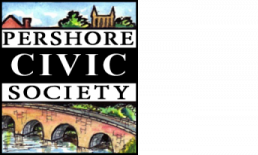Interactive Town Walk
Time: Approx 1-2 hours.
Click on markers/names for more information
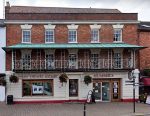
Number 8 Community Arts Centre in High Street (the building dates back to 1741) is a registered charity and was opened in December 2004 to the public and officially opened in 2006 by HRH Duke of Edinburgh. Funding for the Art Centre was raised by residents of Pershore over a period of 10 years and is operated by a few paid staff and over 200 volunteers helping run the cinema/theatre and coffee bar – not forgetting art exhibitions and meeting rooms for hire.
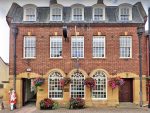 You can return to the High Street via either Church Walk past the town Library or through St Andrews Gardens, through a walk way bounded by a modern serpentine wall originally funded by Advantage West Midlands. You then reach 34 High Street the town’s Post Office built in 1932, which now houses the Town Council Offices and Visitor Information Centre.
You can return to the High Street via either Church Walk past the town Library or through St Andrews Gardens, through a walk way bounded by a modern serpentine wall originally funded by Advantage West Midlands. You then reach 34 High Street the town’s Post Office built in 1932, which now houses the Town Council Offices and Visitor Information Centre.
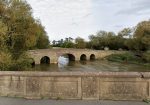 On to the old bridge which is mediaeval, though often repaired and altered in later times. Note the different stone which was used to repair the centre arch, a reminder of its attempted destruction in 1644 by King Charles 1’s army retreating to Worcester
On to the old bridge which is mediaeval, though often repaired and altered in later times. Note the different stone which was used to repair the centre arch, a reminder of its attempted destruction in 1644 by King Charles 1’s army retreating to Worcester
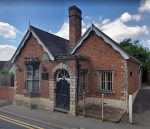 Returning towards the town, a Victorian toll house can be seen on the left (bearing a Civic Society plaque) and just behind it a path follows a serpentine brick wall, one of a number of examples in Pershore of this unusual feature.
Returning towards the town, a Victorian toll house can be seen on the left (bearing a Civic Society plaque) and just behind it a path follows a serpentine brick wall, one of a number of examples in Pershore of this unusual feature.
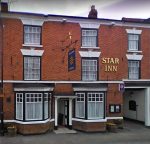 The Star Inn formerly a posting house previously named the Coach and Horses.
The Star Inn formerly a posting house previously named the Coach and Horses.
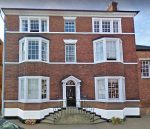 Stanhope House, built about 1790 by another George Perrott, nephew of the judge.
Stanhope House, built about 1790 by another George Perrott, nephew of the judge.
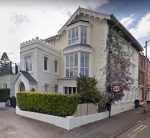 At what was the Manor House Hotel (an early Victorian building now converted into apartments) the town finishes abruptly owing to the river meadows which often flood.
At what was the Manor House Hotel (an early Victorian building now converted into apartments) the town finishes abruptly owing to the river meadows which often flood.
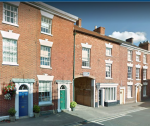 Nos. 37-43 Bridge Street originated as the Maidenhead Inn and a landing place for the barge trade.
Nos. 37-43 Bridge Street originated as the Maidenhead Inn and a landing place for the barge trade.
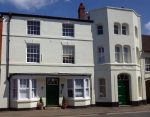 Next door is what was the Brandy Cask pub, formerly named the Liquor Vaults and originally a wool warehouse. It has recently been converted into residential apartments and renamed The Cooperage.
Next door is what was the Brandy Cask pub, formerly named the Liquor Vaults and originally a wool warehouse. It has recently been converted into residential apartments and renamed The Cooperage.
 Perrott House built about 1770 by Judge Perrott. Retiring to Pershore, he restored the weirs and locks of the Avon navigation, thus laying the foundation of the town’s prosperity in the late 18th century.
Perrott House built about 1770 by Judge Perrott. Retiring to Pershore, he restored the weirs and locks of the Avon navigation, thus laying the foundation of the town’s prosperity in the late 18th century.
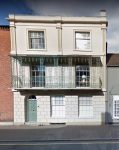 Bedford House with its decorative balcony
Bedford House with its decorative balcony
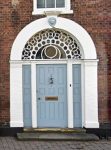 Large town house previously occupied by Barclays Bank having a particularly interesting front door with a late 18th century fanlight of unusual design of interlocking circular ornaments.
Large town house previously occupied by Barclays Bank having a particularly interesting front door with a late 18th century fanlight of unusual design of interlocking circular ornaments.
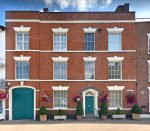 No.1 Bridge Street was another Ganderton home
No.1 Bridge Street was another Ganderton home
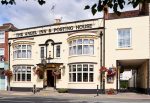 A few more steps will bring you to the elegant façade of the Angel Inn of Tudor origin, the lane at the side once called Quay Street leading to the river Avon.
A few more steps will bring you to the elegant façade of the Angel Inn of Tudor origin, the lane at the side once called Quay Street leading to the river Avon.
 Whilst traversing the High Street, Inspect the fine doorway of No.37 High Street, formerly the home of the Wilson family who were tanners until 1835. The tannery works behind the house have been excavated and the plans are displayed at the Heritage Centre in the Town Hall just across the road.
Whilst traversing the High Street, Inspect the fine doorway of No.37 High Street, formerly the home of the Wilson family who were tanners until 1835. The tannery works behind the house have been excavated and the plans are displayed at the Heritage Centre in the Town Hall just across the road.
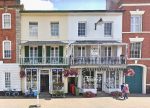 Two shops facing the entrance to Broad Street also have Regency balconies, flanked by an imposing group of Georgian houses built about 1810.
Two shops facing the entrance to Broad Street also have Regency balconies, flanked by an imposing group of Georgian houses built about 1810.
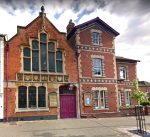 Baptist Chapel, a Victorian building on the site of one of the earliest Baptist foundations in the country, thought to date from 1658. Inside its gallery fronts are panels reached by a graceful curving stairway.
Baptist Chapel, a Victorian building on the site of one of the earliest Baptist foundations in the country, thought to date from 1658. Inside its gallery fronts are panels reached by a graceful curving stairway.
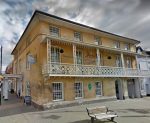 This Regency building was formerly the The Royal Three Tuns Hotel visited in 1830 by Princess (later Queen) Victoria and her mother the Duchess of Kent.
This Regency building was formerly the The Royal Three Tuns Hotel visited in 1830 by Princess (later Queen) Victoria and her mother the Duchess of Kent.
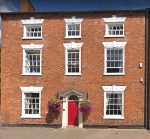
Both no.7 and no.9 are perfect examples of Georgian domestic architecture.
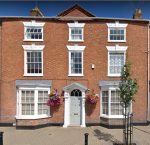 Perfect example of Georgian domestic architecture, no. 9 also has well proportioned bay windows with a pediment at roof line emphasising the symmetry of the elevation.
Perfect example of Georgian domestic architecture, no. 9 also has well proportioned bay windows with a pediment at roof line emphasising the symmetry of the elevation.
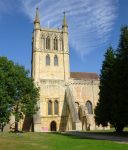 Considered to be Pershore’s treasure. The Abbey was founded in 689. Late in the 10th century it became a well organised Benedictine monastery, but almost at once it suffered heavy financial losses when many of its local estates, including much property in Pershore itself, were seized and made over to the newly founded Abbey of Westminster. It remained however, a monastery of considerable importance with a church of architectural distinction. The original Saxon church, traces of which were discovered during the recent restoration, was rebuilt in Norman Romanesque, seen in the tower arches and the south transept. In 1223 a fire ruined the Norman presbytery when the tower fell destroying the roof.
Considered to be Pershore’s treasure. The Abbey was founded in 689. Late in the 10th century it became a well organised Benedictine monastery, but almost at once it suffered heavy financial losses when many of its local estates, including much property in Pershore itself, were seized and made over to the newly founded Abbey of Westminster. It remained however, a monastery of considerable importance with a church of architectural distinction. The original Saxon church, traces of which were discovered during the recent restoration, was rebuilt in Norman Romanesque, seen in the tower arches and the south transept. In 1223 a fire ruined the Norman presbytery when the tower fell destroying the roof.
The blackened stones were cleared and the new, Early English eastern limb replaced them. The vaulting, with its wonderful carved bosses, is of the following century. In the 14th century the fallen Norman tower was replaced by the present one, designed probably by the same architect as Salisbury Cathedral. At the dissolution of the monasteries, Pershore went the way of other religious houses, and its domestic buildings are no more. An extensive Victorian restoration was carried out between 1862-64 by Sir Gilbert Scott followed in 1992-96 by another especially to the south transept and tower whilst inside a new floor was laid over underfloor heating when new lighting and acoustic systems were also installed.
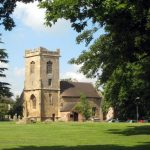 St. Andrew’s opposite is another mediaeval church serving the tenants of the Abbot of Westminster; it has now been de-consecrated and is available for community use.
St. Andrew’s opposite is another mediaeval church serving the tenants of the Abbot of Westminster; it has now been de-consecrated and is available for community use.
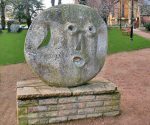 In St. Andrews Gardens is a two-sided modern sculpture The Moon Goddess by Peter Inchbald.
In St. Andrews Gardens is a two-sided modern sculpture The Moon Goddess by Peter Inchbald.
 Passing through the open grounds of Abbey Park which was purchased after the war by a far-sighted local authority and formerly the monastic precincts, the bottom of Newlands is reached. The half timbered structure on the left has been faithfully and beautifully restored by the Worcestershire Historic Buildings Preservation Trust and is thought to be on the site of the Almonry where the monks housed their visitors and dispensed charity to the poor.
Passing through the open grounds of Abbey Park which was purchased after the war by a far-sighted local authority and formerly the monastic precincts, the bottom of Newlands is reached. The half timbered structure on the left has been faithfully and beautifully restored by the Worcestershire Historic Buildings Preservation Trust and is thought to be on the site of the Almonry where the monks housed their visitors and dispensed charity to the poor.
Looking for the old version of the Town Walk? It’s HERE
